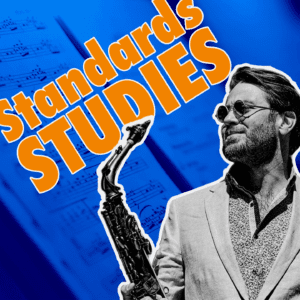This is an in-depth educational course focused on the jazz standard “Stella by Starlight” composed by Victor Young in 1944 for the movie The Uninvited. It thoroughly explores the piece from multiple musical perspectives, starting with the original handwritten score and comparing it to modern versions used by jazz musicians today. Your instructor analyzes the harmonic progression in great detail, discussing specific chord spellings, voice leading, and substitutions, highlighting subtle differences between versions and their theoretical implications. The course also breaks down the melody and explains how it interacts with chords.
Furthermore, the course covers advanced concepts such as diatonic and non-diatonic tensions, chord scales, bebop scale options, and how these relate to improvisation and voicing choices. Exercises on triads and tetrads with voice leading are provided to help learners internalize harmonic movement musically. The instructor also discusses the form of the song, which is more complex than typical jazz standards, making it suitable for advanced students. Throughout, the course encourages creativity within theoretical frameworks, aiming to improve both understanding and practical application of harmony, melody, and improvisation techniques related to this classic tune.
Enjoy this comprehensive masterclass designed for serious jazz musicians and students seeking a deep analytical and practical grasp of “Stella by Starlight.”
Introduction (English):
Introduction (French):
Listen to the playlist and let me know in the comments which is your favorite version!
Video lessons
Lyrics:
Through years of endless springs
The murmur of a brook at eventide
That ripples through a nook where two lovers hide
That’s Stella by starlight
And not a dream
My heart and I agree
She’s everything on earth to me
Oops! This content is for members only — unlock it by upgrading your membership and take your jazz journey to the next level!
Oops! This content is for members only — unlock it by upgrading your membership and take your jazz journey to the next level!
Oops! This content is for members only — unlock it by upgrading your membership and take your jazz journey to the next level!
Summary
Introduction to Stella by Starlight
“Stella by Starlight,” composed by Victor Young in 1944 for the movie The Uninvited, is a timeless jazz standard that offers rich harmonic and melodic complexity. This course delves into the detailed harmonic and melodic analysis of the song, comparing original and modern versions, and provides practical insights into voice leading, tensions, and improvisation techniques for jazz musicians.
The Origins and Historical Context
Victor Young originally composed “Stella by Starlight” as a film score piece, featured during the opening credits and key scenes of The Uninvited. The song’s haunting and evocative mood complements the ghostly narrative of the movie, making it a unique standard in both film and jazz repertoires.
Analyzing the Original Score
Handwritten Manuscript Overview
The original manuscript, preserved and analyzed with the help of pianist Jonathan Huber, shows the piece in D major, unlike the commonly played B flat major key in jam sessions and lead sheets.
Key and Meter
- Original key: D major
- Common jazz jam session key: B flat major
- Metric alterations: Mix of 3/4, 2/4, and 4/4, reflective of the film score’s pacing, but usually standardized to 4/4 in jazz performances.
Harmonic Progression: Original vs. Modern Versions
Original Harmonic Features
- The opening chord is often misinterpreted as a D diminished 7; however, Victor Young’s notation points to a G# diminished 7, indicating a different harmonic function linked to E7b9 resolving to A.
- The progression features sophisticated voice leading, using inversions and passing diminished chords that create tension and smooth resolutions.
- Notable chords include diminished chords functioning as substitutes or approach chords, minor 6 chords, and backdoor dominants.
Modern Jazz Adaptations
- The “Real Book” and Miles Davis versions differ slightly, with the latter simplifying some bass movements and harmonic substitutions for a more straightforward two-five-one progression.
- Modern jazz players often incorporate related minor chords and extended dominant substitutions to enrich improvisation options.
Voice Leading and Chord Tones
Triads with Voice Leading
- Smooth melodic motion is achieved by maintaining common tones between chords and moving other voices stepwise or by minimal intervals.
- Example: Transitioning between E minor 7 flat 5 and A7 involves keeping the E note common while shifting other chord tones in a musically logical manner.
Tetrads and Extended Voicings
- Four-note chords (1-3-5-7) are voiced to preserve tension and resolution tendencies.
- Voice leading emphasizes minimal movement between chord tones, enhancing harmonic coherence and musicality.
Diatonic and Non-diatonic Tensions
Understanding Tensions
- Diatonic tensions fit within the key signature (B flat major for most performances) and include 9ths, 11ths, and 13ths that color chords without clashing with the overall tonality.
- Non-diatonic tensions contain accidentals or altered extensions (e.g., flat 9, sharp 9, sharp 11, flat 13) that create dissonance and are used primarily on dominant chords for color and tension.
Application in Stella by Starlight
- The melody frequently targets chord tensions, such as the 11th resolving to the 3rd or the flat 13, creating a sophisticated interplay between harmony and melody.
- Dominant chords (A7b9, D7, G7, etc.) accept the widest variety of tensions, including flat 9s and sharp 11s, enriching improvisational possibilities.
Melodic Structure and Rhythm
Melodic Construction
- The melody is largely diatonic to B flat major with only two non-diatonic notes: a sharp 4 and a flat 6, both resolving into chord tones.
- Melodic phrases are organized into four eight-bar sections (A, B, C, D), each with distinct melodic ideas yet sharing rhythmic similarities, making the form complex and advanced.
Rhythmic Patterns
- The rhythmic motifs repeat with slight variations, supporting the melodic contours and harmonic shifts.
- The use of repeated rhythmic phrases and motivic development enhances memorability despite the advanced harmonic structure.
Chord Scales and Bebop Scale Applications
Parent Scales for Chords
- Each chord in the progression corresponds to specific parent scales, such as:
- E half diminished: E Locrian (F major scale) or Locrian natural 2 (G melodic minor)
- A7b9: D harmonic minor scale
- C minor 7: C Dorian (B flat major scale)
- Backdoor dominants (A flat7, E flat7) often use melodic minor-derived modes for color.
Bebop Scale Exercises
- Bebop scales (e.g., C7 bebop scale, F7 bebop scale) are used to outline chord tones and tensions while providing chromatic passing tones for fluid improvisation.
- Practicing bebop scales over two-five-one progressions in the song develops rhythmic precision and harmonic awareness.
Practical Exercises for Jazz Musicians
Triads and Tetrads Voice Leading
- Practice moving triads and tetrads smoothly between chords, focusing on common tones and minimal melodic leaps.
- Experiment with inversions and voice leading patterns to internalize harmonic movement.
Improvise Using Diatonic and Non-diatonic Tensions
- Start by improvising with only diatonic notes from B flat major to develop melodic coherence.
- Gradually incorporate non-diatonic tensions such as flat 9s and sharp 11s to add color and tension to solos.
Scale Practice Over Chord Changes
- Practice the relevant modes and bebop scales over each chord type in the progression to develop fluency and harmonic vocabulary.
- Target chord tones and tensions as landing points in your solos for a strong harmonic connection.
Conclusion: Mastering Stella by Starlight
“Stella by Starlight” is not just a jazz standard but a masterclass in harmonic sophistication, melodic nuance, and voice leading artistry. Through detailed analysis of the original and modern versions, along with practical exercises on tensions and scales, jazz musicians can deepen their understanding and performance of this iconic piece. Whether you are analyzing the score, improvising, or arranging, this song offers endless opportunities to expand your jazz vocabulary.
FAQ
Q1: Why is the original key D major, but the jazz standard is played in B flat?
A1: The original score was composed in D major for the film, but jazz musicians commonly transpose it to B flat for ease of playing and compatibility with brass instruments. Notice Stan Getz played it in G.
Q2: What is the importance of diminished chords in this song?
A2: Diminished chords function as passing or approach chords, often derived from secondary dominants, adding tension and smooth voice leading to the progression. The easiest chord scale choice to use over a diminished 7th chord is the whole step half step diminished scale.
Q3: How do diatonic and non-diatonic tensions affect improvisation?
A3: Diatonic tensions stay within the key and provide consonant color, while non-diatonic tensions add dissonance and excitement, especially on dominant chords, enriching solos.
Q4: What scale should I practice for the A7b9 chord?
A4: The A mixolydian b2 b6 is a good choice for A7b9, providing the flat 9 and flat 13 tensions, characteristics of a dominant chord resolving to a minor chord. You can also use the altered scale to add even more tensions.
By mastering the harmonic intricacies and melodic beauty of “Stella by Starlight,” jazz musicians can elevate their playing and improvisation to new artistic heights. Keep practicing, exploring, and swinging!


7 Responses
Stella By Starlight with the Emeo 🙂
I was practicing “First Song” by Charlie Haden and noticed some harmonic similarities with Stella!
I like all versions for different reasons and I like this one for the solos of Kenny Barron and Rufus Reid: https://www.youtube.com/watch?v=Q0WSCY7Cbxo
Thank you Alex, very interesting and dense
That’s true this lesson is pretty dense, I spent a lot of time analyzing and comparing the original and the new harmonic progression because I find this really interesting, specially with the piano score by Victor Young himself, a great voice leading study!
The movie “The Uninvited”
https://archive.org/details/the-uninvited-1944-bluray
J’aime aussi beaucoup la version de Keith Jarrett dont Antoine Hervé dissèque l’introduction avec une exquise gourmandise : https://youtu.be/U8PfKnrUG4Q?si=_R2jh2RmjGO-TWr8